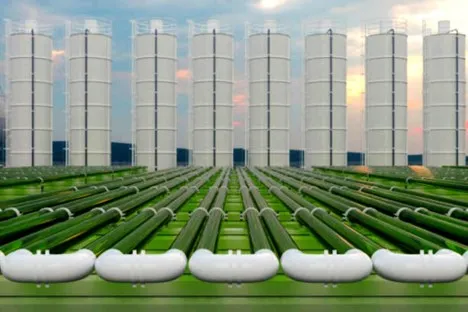How to Reduce CO2 GHG Emissions in the Transportation Sector
With the transportation sector being the largest source of GHG emissions in the U.S.1, the increasing number of both public- and private-sector entities with carbon reduction goals have set their sights on reducing engine emissions as an important step toward achieving their targets.
While several options are available, one with high potential to make a more immediate and widespread impact across nearly every mode of transportation is renewable fuels, which includes biodiesel and renewable diesel.
Availability: biofuels vs. electric vehicles
One of the most commonly discussed solutions to reducing carbon emissions is the move toward electric vehicles. While electric vehicle availability and charging infrastructure has come a long way in the passenger car market over the last decade, it still has a long way to go in the commercial transportation industry, which accounts for at least 40% of transportation sector emissions between medium- and heavy-duty trucks, aircraft, rail, and ships and boats.1 While manufacturers like Tesla, Volvo and Daimler have all recently debuted battery-electric trucks and begun testing with companies like Walmart, Bloomberg New Energy Finance estimates that only 19% of heavy-duty trucks will be electrified by the year 2040.2 By contrast, bio-based fuels are available today and don’t require significant infrastructure investment or equipment modifications. And the impact may be greater than many realize.

Is biodiesel more effective than electricity at reducing carbon?
In addition to the availability and ease-of-transition benefits of bio-based fuels, the carbon reduction impact may be surprising — especially in comparison to electric vehicles. In fact, biodiesel may be 56% more effective in reducing carbon than electricity, when taking the fossil fuel based electrical grid into consideration.3
It’s important to not only look at tailpipe emissions, but to look at the total lifecycle emissions of a power source, including emissions associated with its production, transport, and use. The California Air Resources Board (CARB) has a calculation for this called a Carbon Intensity (CI) score. The lower the CI score, the lower its lifecycle emissions. The CI score for electricity in California has consistently been higher — often significantly higher — than the CI score for biodiesel over the last five years.4 And while that gap has narrowed over the last couple of years in California, it’s fair to assume the gap is much wider in states with fewer lower carbon sources of power generation. For example, – California generates 0.1% of its electricity from coal, whereas the average of all 50 states plus Washington, D.C. is 22.8%. Some states, like West Virginia, are as high as 90.8%.5 That’s around 908 times greater than in California, where the CI score for electricity is still higher than biodiesel.
Biodiesel vs. diesel carbon emissions
With internal combustion engines not going away anytime soon, a simple switch to biodiesel is one of the easiest ways to make an impact today – and well into the future. Just how much of an impact does it make? Versus petroleum diesel, biodiesel can reduce emissions by:
- Up to 100% for fossil carbon6
- Up to 70% for total hydrocarbon7
- Up to 70% for particulate matter7
For an estimate of how much your fleet could reduce emissions by switching to biodiesel, try our CO2 emissions calculator.
How do I choose the right bio-based fuel?
Chevron Renewable Energy Group offers an extensive line of fuel solutions in the EnDura FuelsTM family, which can help meet your unique lower carbon and profitability goals. Those fuels include:
- InfiniD™ is a biodiesel solution that can provide engine performance and emissions benefits to fleets looking to reach lower carbon goals economically. InfiniD™ is suitable for use in marine, trucking, railroad and a variety of off-the-road equipment types, such as those used in construction, agriculture or mining.
- PuriD™ is a next generation “Ultra Biodiesel” that provides virtually seamless blending with renewable diesel and also enables higher blend levels with petroleum diesel year-round, managed with the same cold flow properties used to handle petroleum fuels. PuriD™ is most often used in trucking and railroad applications.
- VelociD™ is an ultra-high cetane renewable diesel that acts as a direct replacement to petroleum diesel – providing maximum engine performance, while reducing carbon emissions. VelociD™ is most commonly used in trucking, but can serve as a replacement for petroleum diesel in nearly any application.
- UltraClean BlenD™ is a proprietary, renewable fuel combination of VelociD™ and PuriD™ that allows for reduced carbon intensity today in virtually any diesel application, and is most frequently used in trucking and railroad applications.
- BeyonD™ is a sustainable aviation fuel (SAF) blendstock that meets specifications and reduces lifecycle carbon emissions compared to petroleum jet fuel in the aviation industry.
What should I look for in a biodiesel supplier?
- Track Record: First, look for a solid track record of the supplier serving customers in your area and industry. Chevron Renewable Energy Group has case studies in a variety of industries with well-known customers such as Union Pacific, Manchester United and the City of Madison.
- Fuel Quality: Next, ensure the supplier meets or exceeds stringent quality standards, such ASTM, CEN and CGSB.
- Supply: Confirm your biofuels provider can meet your supply needs. Chevron Renewable Energy Group has 11 biorefineries, feedstock flexibility, an impressive infrastructure of terminals and truck assets, and an increasing number of partnerships and outlets that bring EnDura Fuels™ to the pump or straight to your facility.
- GHG Reporting: A decision to switch to bio-based fuels is often driven by a need to quantify scope 1 GHG emissions reductions. Chevron Renewable Energy Group helps our customers by providing a monthly summary report that estimates metric tons of GHG emissions avoided by using our lower carbon fuels. Learn more about carbon emissions reporting.
- Technical Support: The Chevron Renewable Energy Group team is accessible to consult with customers and offer additional support services such as fuel testing and analysis, and in some areas, a range of fuel services such as delivery, lubricant services, fuel reclamation, tank cleaning and other support or assistance. Check out our fuel services.
Ready to make the switch?
Contact us to discuss how we can be your lower carbon fuel partner.
Chevron Renewable Energy Group is leading the energy and transportation industries’ transition to lower carbon by converting renewable resources into high-quality fuels. We are an international producer of lower carbon fuels that significantly lower greenhouse gas emissions to immediately reduce carbon impact. Chevron Renewable Energy Group utilizes a global integrated procurement, distribution and logistics network to operate 11 biorefineries in the U.S. and Europe. In 2021, the business produced 480 million gallons delivering 4.1 million metric tons of carbon reduction. Chevron acquired Renewable Energy Group in June 2022.
Renewable Energy Group, REG, the logo and the other trademarks and trade names referenced herein are trademarks of Chevron U.S.A. Inc. © 2023 Chevron U.S.A. All Rights Reserved.
The information contained herein is believed to be reliable but Chevron Renewable Energy Group makes no representations concerning the accuracy or correctness of the data. These products, like any other should be tested by the customer/user thoroughly under end user conditions to ensure the product meets the particular requirements. Independent results may vary.
SOURCES
- https://www.epa.gov/greenvehicles/fast-facts-transportation-greenhouse-gas-emissions
- https://blogs.edf.org/energyexchange/2020/09/22/walmart-commits-to-100-zero-emission-trucks-by-2040-signaling-electric-is-the-future/
- Carbon intensity for EVs based on eGRID 2020 figures and EV EER of 3.8 for transit buses per National Renewable Energy Laboratory
- https://ww2.arb.ca.gov/resources/documents/low-carbon-fuel-standard-reporting-tool-quarterly-summaries
- https://www.nei.org/resources/statistics/state-electricity-generation-fuel-shares
- Product is produced from renewable oils and fats. Methanol used to make biodiesel and hydrogen used to make renewable diesel and SAF are typically made from conventional natural gas, but can be produced from renewable resources
- CARB Assessment of the Emissions from the Use of Biodiesel as a Motor Vehicle Fuel in California "Biodiesel Characterization and NOx Mitigation Study." Durbin (2011)
The above article is sponsor-generated content. To learn more about sponsor-generated content, click here.


